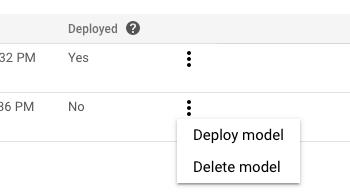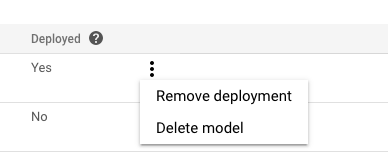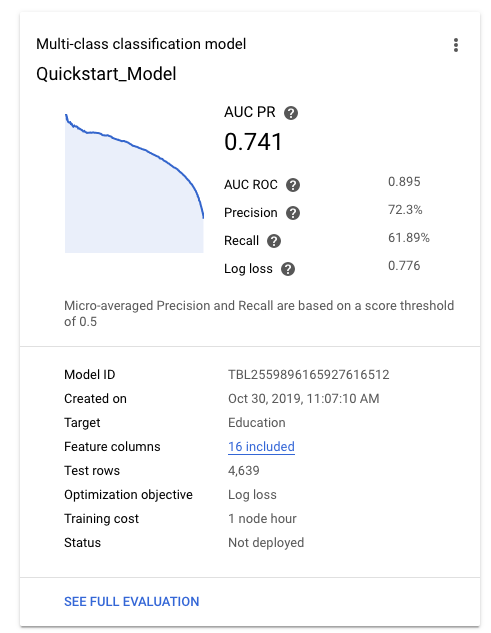Nesta página, você verá como implantar, remover a implantação, listar, excluir e receber informações sobre seus modelos personalizados usando o AutoML Tables.
Para ver informações sobre como treinar um novo modelo, consulte Como treinar modelos.
Como implantar um modelo
Após treinar o modelo, implante-o antes de usa-lo para solicitar predições online. É possível solicitar predições em lote de um modelo não implantado.
A implantação do modelo gera cobranças. Para mais informações, consulte a página de preços.
Console
Acesse a página do AutoML Tables no console do Google Cloud.
Selecione a guia Modelos, no painel de navegação à esquerda e selecione a Região.
No menu Mais ações, do modelo que você quer implantar, clique em Implantar modelo.

REST
Use o método models.deploy para implantar o modelo.Antes de usar os dados da solicitação, faça as substituições a seguir:
-
endpoint:
automl.googleapis.compara o local global eeu-automl.googleapis.compara a região da UE. - project-id: é seu ID do projeto no Google Cloud.
- location: o local do recurso:
us-central1para global oueupara a União Europeia. -
model-id: o código do modelo que você quer implantar. Por exemplo,
TBL543.
Método HTTP e URL:
POST https://endpoint/v1beta1/projects/project-id/locations/location/models/model-id:deploy
Para enviar a solicitação, escolha uma destas opções:
curl
execute o seguinte comando:
curl -X POST \
-H "Authorization: Bearer $(gcloud auth print-access-token)" \
-H "x-goog-user-project: project-id" \
-H "Content-Type: application/json; charset=utf-8" \
-d "" \
"https://endpoint/v1beta1/projects/project-id/locations/location/models/model-id:deploy"
PowerShell
execute o seguinte comando:
$cred = gcloud auth print-access-token
$headers = @{ "Authorization" = "Bearer $cred"; "x-goog-user-project" = "project-id" }
Invoke-WebRequest `
-Method POST `
-Headers $headers `
-Uri "https://endpoint/v1beta1/projects/project-id/locations/location/models/model-id:deploy" | Select-Object -Expand Content
Você receberá uma resposta JSON semelhante a esta:
{
"name": "projects/292381/locations/us-central1/operations/TBL543",
"metadata": {
"@type": "type.googleapis.com/google.cloud.automl.v1beta1.OperationMetadata",
"createTime": "2019-12-26T19:21:00.550021Z",
"updateTime": "2019-12-26T19:21:00.550021Z",
"worksOn": [
"projects/292381/locations/us-central1/models/TBL543"
],
"deployModelDetails": {},
"state": "RUNNING"
}
}
A implantação de um modelo é uma operação de longa duração. É possível pesquisar o status de uma operação ou esperar que ela seja retornada. Saiba mais.
Java
Se os recursos estiverem localizados na região da UE, você precisará definir o endpoint explicitamente. Saiba mais.
Node.js
Se os recursos estiverem localizados na região da UE, você precisará definir o endpoint explicitamente. Saiba mais.
Python
A biblioteca de cliente para AutoML Tables inclui outros métodos Python que simplificam o uso da API AutoML Tables. Esses métodos se referem aos conjuntos de dados e aos modelos pelos nomes e não pelos IDs. É preciso que os nomes dos conjuntos de dados e modelos sejam exclusivos. Para mais informações, consulte a Referência do cliente.
Se os recursos estiverem localizados na região da UE, você precisará definir o endpoint explicitamente. Saiba mais.
Como remover a implantação de um modelo
Para solicitar previsões on-line, primeiro você precisa implantar seu modelo. Para evitar cobranças desnecessárias, é possível remover a implantação do modelo quando você não precisar mais dele para fazer previsões on-line.
Para informações sobre cobranças de implantação, consulte a página de preços.
Console
Acesse a página do AutoML Tables no console do Google Cloud.
Selecione a guia Modelos, no painel de navegação à esquerda e selecione a Região.
No menu Mais ações, do modelo que você pretende remover, clique em Remover implantação.

REST
Use o método models.undeploy para remover a implantação de um modelo.Antes de usar os dados da solicitação, faça as substituições a seguir:
-
endpoint:
automl.googleapis.compara o local global eeu-automl.googleapis.compara a região da UE. - project-id: é seu ID do projeto no Google Cloud.
- location: o local do recurso:
us-central1para global oueupara a União Europeia. -
model-id: o código do modelo que você quer remover. Por exemplo,
TBL543.
Método HTTP e URL:
POST https://endpoint/v1beta1/projects/project-id/locations/location/models/model-id:undeploy
Para enviar a solicitação, escolha uma destas opções:
curl
execute o seguinte comando:
curl -X POST \
-H "Authorization: Bearer $(gcloud auth print-access-token)" \
-H "x-goog-user-project: project-id" \
-H "Content-Type: application/json; charset=utf-8" \
-d "" \
"https://endpoint/v1beta1/projects/project-id/locations/location/models/model-id:undeploy"
PowerShell
execute o seguinte comando:
$cred = gcloud auth print-access-token
$headers = @{ "Authorization" = "Bearer $cred"; "x-goog-user-project" = "project-id" }
Invoke-WebRequest `
-Method POST `
-Headers $headers `
-Uri "https://endpoint/v1beta1/projects/project-id/locations/location/models/model-id:undeploy" | Select-Object -Expand Content
Você receberá uma resposta JSON semelhante a esta:
{
"name": "projects/292381/locations/us-central1/operations/TBL543",
"metadata": {
"@type": "type.googleapis.com/google.cloud.automl.v1beta1.OperationMetadata",
"createTime": "2019-12-26T19:19:21.579163Z",
"updateTime": "2019-12-26T19:19:21.579163Z",
"worksOn": [
"projects/292381/locations/us-central1/models/TBL543"
],
"undeployModelDetails": {},
"state": "RUNNING"
}
}
Java
Se os recursos estiverem localizados na região da UE, você precisará definir o endpoint explicitamente. Saiba mais.
Node.js
Se os recursos estiverem localizados na região da UE, você precisará definir o endpoint explicitamente. Saiba mais.
Python
A biblioteca de cliente para AutoML Tables inclui outros métodos Python que simplificam o uso da API AutoML Tables. Esses métodos se referem aos conjuntos de dados e aos modelos pelos nomes e não pelos IDs. É preciso que os nomes dos conjuntos de dados e modelos sejam exclusivos. Para mais informações, consulte a Referência do cliente.
Se os recursos estiverem localizados na região da UE, você precisará definir o endpoint explicitamente. Saiba mais.
Como conseguir informações sobre um modelo
Quando o treinamento estiver concluído, será possível conseguir informações sobre o modelo recém-criado.
Console
Acesse a página do AutoML Tables no console do Google Cloud.
Selecione a guia Modelos no painel de navegação à esquerda e depois selecione um modelo para ver as informações dele.
Selecione a guia Treinar.
É possível ver métricas de alto nível do modelo, como precisão e recall.

Se você precisar de ajuda para avaliar a qualidade do modelo, consulte Como avaliar modelos.
REST
Use o método models.get para receber informações sobre um model.
Antes de usar os dados da solicitação, faça as substituições a seguir:
-
endpoint:
automl.googleapis.compara o local global eeu-automl.googleapis.compara a região da UE. - project-id: é seu ID do projeto no Google Cloud.
- location: o local do recurso:
us-central1para global oueupara a União Europeia. -
model-id: o código do modelo sobre o qual você quer receber informações. Por exemplo,
TBL543.
Método HTTP e URL:
GET https://endpoint/v1beta1/projects/project-id/locations/location/models/model-id
Para enviar a solicitação, escolha uma destas opções:
curl
execute o seguinte comando:
curl -X GET \
-H "Authorization: Bearer $(gcloud auth print-access-token)" \
-H "x-goog-user-project: project-id" \
"https://endpoint/v1beta1/projects/project-id/locations/location/models/model-id"
PowerShell
execute o seguinte comando:
$cred = gcloud auth print-access-token
$headers = @{ "Authorization" = "Bearer $cred"; "x-goog-user-project" = "project-id" }
Invoke-WebRequest `
-Method GET `
-Headers $headers `
-Uri "https://endpoint/v1beta1/projects/project-id/locations/location/models/model-id" | Select-Object -Expand Content
Você receberá uma resposta JSON semelhante a esta:
Java
Se os recursos estiverem localizados na região da UE, você precisará definir o endpoint explicitamente. Saiba mais.
Node.js
Se os recursos estiverem localizados na região da UE, você precisará definir o endpoint explicitamente. Saiba mais.
Python
A biblioteca de cliente para AutoML Tables inclui outros métodos Python que simplificam o uso da API AutoML Tables. Esses métodos se referem aos conjuntos de dados e aos modelos pelos nomes e não pelos IDs. É preciso que os nomes dos conjuntos de dados e modelos sejam exclusivos. Para mais informações, consulte a Referência do cliente.
Se os recursos estiverem localizados na região da UE, você precisará definir o endpoint explicitamente. Saiba mais.
Como listar modelos
Um projeto pode incluir vários modelos treinados usando conjuntos de dados iguais ou diferentes.
Console
Para ver uma lista dos modelos disponíveis usando o Console do Google Cloud, clique na guia Modelos na barra de navegação à esquerda e selecione a Região.
REST
Para ver uma lista dos modelos disponíveis para uso com a API, use o método models.list.
Antes de usar os dados da solicitação, faça as substituições a seguir:
-
endpoint:
automl.googleapis.compara o local global eeu-automl.googleapis.compara a região da UE. - project-id: é seu ID do projeto no Google Cloud.
- location: o local do recurso:
us-central1para global oueupara a União Europeia.
Método HTTP e URL:
GET https://endpoint/v1beta1/projects/project-id/locations/location/models
Para enviar a solicitação, escolha uma destas opções:
curl
execute o seguinte comando:
curl -X GET \
-H "Authorization: Bearer $(gcloud auth print-access-token)" \
-H "x-goog-user-project: project-id" \
"https://endpoint/v1beta1/projects/project-id/locations/location/models"
PowerShell
execute o seguinte comando:
$cred = gcloud auth print-access-token
$headers = @{ "Authorization" = "Bearer $cred"; "x-goog-user-project" = "project-id" }
Invoke-WebRequest `
-Method GET `
-Headers $headers `
-Uri "https://endpoint/v1beta1/projects/project-id/locations/location/models" | Select-Object -Expand Content
Java
Se os recursos estiverem localizados na região da UE, você precisará definir o endpoint explicitamente. Saiba mais.
Node.js
Se os recursos estiverem localizados na região da UE, você precisará definir o endpoint explicitamente. Saiba mais.
Python
A biblioteca de cliente para AutoML Tables inclui outros métodos Python que simplificam o uso da API AutoML Tables. Esses métodos se referem aos conjuntos de dados e aos modelos pelos nomes e não pelos IDs. É preciso que os nomes dos conjuntos de dados e modelos sejam exclusivos. Para mais informações, consulte a Referência do cliente.
Se os recursos estiverem localizados na região da UE, você precisará definir o endpoint explicitamente. Saiba mais.
exclusão de um modelo
A exclusão de um modelo o remove permanentemente do projeto.
Console
Na IU das do AutoML Tables, clique na guia Modelos, no menu de navegação à esquerda e selecione aRegião para exibir a lista de modelos disponíveis para essa região.
Clique no menu de três pontos, à extrema direita da linha que você quer excluir e selecione Excluir modelo.
Clique em Excluir na caixa de diálogo de confirmação.
REST
Para excluir um modelo, use o método models.delete.
Antes de usar os dados da solicitação, faça as substituições a seguir:
-
endpoint:
automl.googleapis.compara o local global eeu-automl.googleapis.compara a região da UE. - project-id: é seu ID do projeto no Google Cloud.
- location: o local do recurso:
us-central1para global oueupara a União Europeia. -
model-id: o código do modelo que você quer excluir. Por exemplo,
TBL543.
Método HTTP e URL:
DELETE https://endpoint/v1beta1/projects/project-id/locations/location/models/model-id
Para enviar a solicitação, escolha uma destas opções:
curl
execute o seguinte comando:
curl -X DELETE \
-H "Authorization: Bearer $(gcloud auth print-access-token)" \
-H "x-goog-user-project: project-id" \
"https://endpoint/v1beta1/projects/project-id/locations/location/models/model-id"
PowerShell
execute o seguinte comando:
$cred = gcloud auth print-access-token
$headers = @{ "Authorization" = "Bearer $cred"; "x-goog-user-project" = "project-id" }
Invoke-WebRequest `
-Method DELETE `
-Headers $headers `
-Uri "https://endpoint/v1beta1/projects/project-id/locations/location/models/model-id" | Select-Object -Expand Content
Você receberá uma resposta JSON semelhante a esta:
{
"name": "projects/29452381/locations/us-central1/operations/TBL543",
"metadata": {
"@type": "type.googleapis.com/google.cloud.automl.v1beta1.OperationMetadata",
"createTime": "2019-12-26T17:19:50.684850Z",
"updateTime": "2019-12-26T17:19:50.684850Z",
"deleteDetails": {},
"worksOn": [
"projects/29452381/locations/us-central1/models/TBL543"
],
"state": "DONE"
},
"done": true,
"response": {
"@type": "type.googleapis.com/google.protobuf.Empty"
}
}
A exclusão de um modelo é uma operação de longa duração. É possível pesquisar o status de uma operação ou esperar que ela seja retornada. Saiba mais.
Java
Se os recursos estiverem localizados na região da UE, você precisará definir o endpoint explicitamente. Saiba mais.
Node.js
Se os recursos estiverem localizados na região da UE, você precisará definir o endpoint explicitamente. Saiba mais.
Python
A biblioteca de cliente para AutoML Tables inclui outros métodos Python que simplificam o uso da API AutoML Tables. Esses métodos se referem aos conjuntos de dados e aos modelos pelos nomes e não pelos IDs. É preciso que os nomes dos conjuntos de dados e modelos sejam exclusivos. Para mais informações, consulte a Referência do cliente.
Se os recursos estiverem localizados na região da UE, você precisará definir o endpoint explicitamente. Saiba mais.
A seguir
- Avalie o modelo.
- Receba predições em lote do modelo.
- Receba predições on-line do modelo.
- Saiba mais sobre como usar operações de longa duração.
